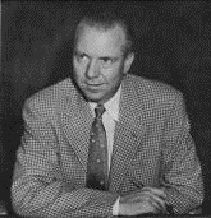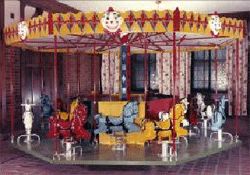

 Playground history was made back in 1927 when John Ahrens founded Miracle Recreation in Grinnell, Iowa. He redesigned the merry-go-round after seeing an exhibit for a “Perpetual Motion Machine.” He called his product, however, the “Miracle Whirl.” Ahrens was awarded a patent and created the company known as Ahrens Manufacturing Company.
Playground history was made back in 1927 when John Ahrens founded Miracle Recreation in Grinnell, Iowa. He redesigned the merry-go-round after seeing an exhibit for a “Perpetual Motion Machine.” He called his product, however, the “Miracle Whirl.” Ahrens was awarded a patent and created the company known as Ahrens Manufacturing Company.
John passed his company to his son, Claude, in 1940. Claude already owned a hybrid seed corn company, but in 1946 he focused his attention on manufacturing and selling the Miracle Whirl. Claude soon sold his seed corn business, and started the Miracle Recreation Equipment Company, formerly known as Ahrens Manufacturing Company.
Almost all of Miracle’s first customers were country schools. The schools bought the Miracle Whirl to entertain their students during recess. During 1947, Miracle’s first year of operation, 900 whirls were sold to schools throughout Iowa. Soon after, Miracle expanded its product offering to include playground equipment such as swings, teeter-totters, and jungle gyms.
Claude set up the production for the Miracle Whirl merry-go-round in the Grinnell Glove Factory. Claude redesigned it to replace the wooden platform with a more durable metal one, eliminating the center post and adding tubing handrails for the children to hold onto. Claude also painted the product with a candy stripe so the product was clearly identifiable, an idea he carried through to other products as well.
When the Grinnell Glove factory burned, Claude set up a new facility on farmland purchased on the west side of Grinnell and hired salesmen to sell his product. By the late 1960s, Miracle had pioneered the use of fiberglass for slides and canopies, which helped to differentiate its products from the competition. Fiberglass allowed Miracle to create colorful components and he was the first playground manufacturer to use powder coating on steel parts during that time.
 One day, after experiencing a splinter while sitting on a wooden bleacher at a University of Iowa football game, Claude next set out to create bleachers made from the fiberglass he used in many of Miracle’s playground items. Miracle replaced all the wooden bleachers at the university with fiberglass coverings, saving the university over $60,000. Orders came in from other large schools such as the University of Michigan and Ohio State. Seating soon became one of Miracle’s most important offerings.
One day, after experiencing a splinter while sitting on a wooden bleacher at a University of Iowa football game, Claude next set out to create bleachers made from the fiberglass he used in many of Miracle’s playground items. Miracle replaced all the wooden bleachers at the university with fiberglass coverings, saving the university over $60,000. Orders came in from other large schools such as the University of Michigan and Ohio State. Seating soon became one of Miracle’s most important offerings.
By 1970, Miracle Recreation Equipment had 200 employees selling and manufacturing playground equipment and bleachers at facilities in Iowa, California and Virginia.
Miracle also was the first to design and manufacture playgrounds and sets for the fast food industry. Miracle purchased the Setmaker Company in California, and with the help of Claude’s son, Paul Ahrens, Miracle created playground designs for fast food giant McDonald’s. Miracle installed play equipment at over 500 McDonald’s throughout the United States. Together, Paul and Claude developed over 16 patents for their designs.
Paul Ahrens became President of Miracle in 1972, the same year the company sold 30 percent of its shares to the public. Paul next announced plans in 1982 to build a new plant in Monett, Missouri.
Paul became chairman of Miracle in late in 1986. By this time, Claude Ahrens had sold all of his stock to his son, giving Paul controlling interest of the company.
But in 1989, Paul lost his battle with cancer. So after putting all his possessions as collateral against the company, Claude bought the firm’s shares back and took over Miracle once again. Claude then sold Miracle Recreation Equipment Company to PlayPower in 2002.

